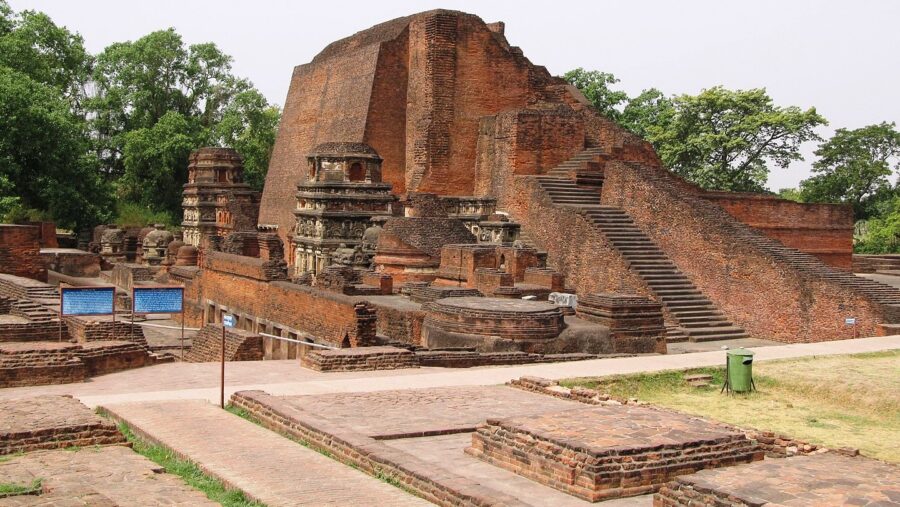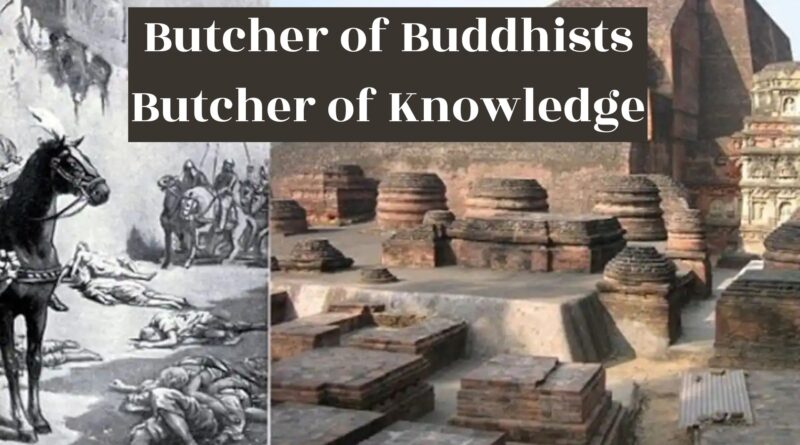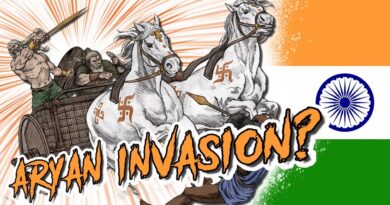Bakhtiyar Khilji–Origin/Campaigns\Defeat and Death
Bakhtiyar Khilji is one of the many Islamic barbaric names that Bharat endured. He is famously known for destroying Nalanda, Vikramshila, and Odantapuri University, the top learning centers around the globe of that time. We will talk about this brute animal in brief, how unlucky he was with his bodily stature? How did a man who was born in the western-most part of Afghanistan end up being dead in the most eastern part of Bharat? How did he start his military campaign and his successes in it? We will also discuss, how and exactly why he destroyed Nalanda University along with the others. But this is very sad, that even today we honor this demon by naming our railway stations after his name, and why does this happen? The pure vote-bank politics, Muslim appeasement, and flawed Secularism are being followed by many politicians to get some votes.

Bakhtiyar Khilji early life: –
Bakhtiyar Khilji was born and raised in the Garmsir area, the eastern side of the Helmand River in present-day Afghanistan. He was of a Turkic origin. He was appointed as a recruiter, supervisor of Army upkeep, etc in Ghor province. He was not satisfied with his job, so he look towards the east for better prospects in Qutub-Uddin Aibak’s army in 1196, but was refused. A Contemporary Historian Minhaj i-Siraj (1193 CE) mentioned how due to his short stature and arms extending beyond his knees, was rejected from armies wherever he went. Then he went further eastward and took a job under a Turkic administrator, he commanded a platoon in Badayun in Northern Uttar Pradesh. After a few years, he went to Awadh, where Malik Husam al-Din gave him a complete estate/jagir which is today’s Mirzapur of Uttar Pradesh.

Military Campaigns of Bakhtiyar Khilji: –
Soon, after he got a Complete Jagir, adventurers from Afghanistan and Central Asia began to flock to his camp. He was strengthening his army to prepare for raids in the rich provinces of Bihar and Bengal in the East. During the years of 1197-1200 CE, he launched a series of multiple raids in Bengal which was under the Sena Kingdom which was ruling and expanding power in the Bengal region since 1095 AD, founded by Hemanta Sena. Bakhtiyar Khilji’s first target was Odantapuri University (Sharif District of Bihar). King Lakshman Sena was technically the ruler of Magadha at that time, although it was not Magadha but considering historical geography, there was a little part of Magadha that he ruled, during this period he was complacent and a number of chiefs became de-facto rulers in his kingdom. Bakhtiyar later burned and devastated Nalanda and Vikramshila University. Thousands of Buddhist monks were burnt alive (Tabawat-I Nasiri by Minhaj-I Siraj). The sacking of two great universities of that time bolstered his confidence since the Lakshman Sena did not react the way, a King should have been.

Bakhtiyar Khilji’s confidence was leveled up further. He started preparing for further attacks. In 1204 CE, he launched a sudden attack on King Lakshman Sena’s capital Nadia. He did not even give a fight to Khilji and fled the capital, leaving innocent people at the mercy of Islamic barbarians. Finally, Bakhtiyar Khilji became the ruler of Bengal. His Military campaigns were becoming seemingly successful, with all these victories his ambitions were also flying over the roof. He thought of further extending to East in Assam (Kamrup) and North in Tibet.
विनाशकाले विपरीत बुद्धि।।
Why Bakhtiyar Khilji burned Nalanda University?
Like all the Islamic Invaders who came from the North-West with an intent to spread Islam through sword and devastate every civilization that existed on the face of the Earth. He was also alike them; his first ambition was to gain more territory and secondly convert people to Islam or Butcher them. Since these are the Islamic teachings from various Islamic scriptures that motivate them to do such heinous acts. In today’s time ISIS, Al-Qaeda, Jaish, etc, are nothing but following the same path that Bakhtiyar Khilji followed. He was also reading the same quotes of the Quran and Hadith as these terror outfits are doing today.
Islamic quotes of decimating Kafirs, Killing, Converting, etc.
| Ibn Qayam-al Joziya
(Sunni Jurisconsult 13th CE) |
1. Places, where Allah and his messenger are disobeyed, must be destroyed. Prophet also ordered that Masjid ad diraar be demolished since it housed hypocrites. Polytheistic monuments deserve to be destroyed even more.
2. Umar Bin Al Khattab set ablaze an entire village where intoxicants were sold. Read the chapter on Destruction of Places of worship (read pg 481)
|
| Riyad as-Salihin 438 (Hadith) | 1. Allah has sent me to destroy idols so that he alone is worshiped (Explicitly mention destroy). |
| 1. Quran—2(256)
2. Quran—9(123)
3. Quran—47(35) |
1. There is no compulsion in Religion because Islam was not in Power when this revelated in Mecca.
2. Muslims, fight the non-Muslims near you. It was revealed when Muhammad became a warlord. 3. Allah will not forgive Kafirs (those who believe in another God than Allah). |
Nalanda, Vikramshila, Odantapuri, etc. These were the great learning centers, where scholars from foreign land used to learn. Bharat used to be the producer of knowledge. Islam came from the land of the desert where assuring the supply of proper food and water was the first priority lest learning any formal higher education in formal University. When Bakhtiyar Conquered the Nalanda districts of present-day Bihar, he observed that there is no teaching of Islam in this University, Library was devoid of any Islamic scriptures, and Idol worship was widespread. So, he did exactly the same thing that Muhammad did during his time, broke all the buddha and Hindu god statues, and killed monks, and teachers who refused to convert to Islam. Burned the entire library of Nalanda to cook grams for his horses, typically the same thing was done by Tipu Sultan in the Mysore Palace library. Its library was so rich that its manuscripts burned for 3 months. Conquering lands and defeating other Kings for more resources is one thing and destroying culture, knowledge, and civilization is completely another. You have to have a very strong reason to do that, and that reason is drawn from Islamic scriptures.

Who Defeated Bakhtiyar Khilji
Bakhtiyar Khilji’s Folly of Kamrup (Assam): –
After defeating weak rulers in Bengal and Bihar, Khilji’s confidence and ambitions skyrocketed. He started planning an attack further East in Kamrup (Assam). He started his Military campaign in Devkot (Bihar). A local Mech chieftain who converted to Islam and named Ali (obviously the fear of sword). Guided Khilji’s army in Kamrup (Assam). In 1206 CE crossing a Stone bridge over the Barnadi river his army entered the territory of Kamrup, after a few more days of marching amid the hilly terrains and treacherous jungles, Khilji and his army reached the kingdom of Kamrup.

There was a strong fort in the middle of the villages. Khilji’s army immediately set to action— looting and plundering villages. Prithu was the king of Assam, they used to worship Goddess Durga which is also visible even today. Kanai Varasi rock inscription records the decimation of the Turkic army in 1206 CE. Watching a sudden attack on villages, Koch Rajbongshi, Bodo, and Keot tribes extended their support to Prithu. The combined Kamrupi forces attacked Khilji’s army with no mercy. Turkic soldiers were flying left and right but there used to be no escape since they have entered a wrong place ruled by a strong King this time. Khilji’s army could not advance and many soldiers were taken as POWs.

The first day of battle was over, huge losses were mounted on Khilji’s army. Khilji was in fear that, king Prithu might pursue him to kill him. So, he decided to fall back to Bengal. He then broke up his camp the very first night of battle and retreated. But the King Prithu had a different plan for the Turkic army, he attacked his retreating army again from the left-right. Khilji again lost most of the lot of his army, some went to 72 Virgins and some were taken as POWs. The imprisoned soldiers sought pardon and shelter under Prithu. He made living arrangements for Mohammedan soldiers without converting them or Jyzia or any other Islamic cruelty that other soldiers have to bear even today. This was a part of the rule of Dharma (not a religion but a duty) that all Hindu kings followed in warfare. That’s how Islam came into Assam, and today same Miya are creating havoc in Assam. Muslims cry for rights when they are in minority, but they ensure that the same rights are not available to non-Muslims when they are in Majority.
Bakhtiyar Khilji’s another folly in Tibet: –
The episode of Kamrup gave him the biggest shock in his life, he lost many men, the morale of his army was grounded and he was struggling to muster his army again. Far in the North was the forbidden land of Tibet. Historically Bengal had trade relations with Tibet along with the “Tea-Horse route” through Assam, Sikkim, and Bhutan. Khilji was keen on securing this trade route to arrange some finance and horses. Since he was in desperation now to win Tibet to come to Kamrup again to teach lessons, he went ahead with his plans in Tibet.
Amassed a large army of 10,000 men Ali Mech marched into Tibet in 1206 CE the same year he got a bloody nose in Assam. He also invited King Prithu to join his plan but Kamrup was not interested. After marching for 15 days through north Bengal and Sikkim his army reached Chumby Valley in Tibet. They faced very little resistance and Tibetans lured them further north. The reason was simply that this new army would succumb to climate first, so his army was falling into the trap of Tibetans.

The rugged Himalayan mountains were unknown and unfamiliar territory for an army that is best suited to the plains and humid climate of Bengal. Lack of oxygen, dehydration, and high inclined marches exhausted his army as was planned by the Tibetans. Then came the attack of Tibetans, when these 5 feet small Tibetans came down into valleys and passes on to the Mohammadi army, they were bringing hell to them. Khilji’s soldiers jumped into chilled rivers to save their lives. Many were taken prisoners, many were killed brutally and many jumped off the cliff, but fortunately, Bakhtiyar Khilji managed to escape. This was his last episode of the military campaign and after this, he became a sick man and retired from the military life.

How Bakhtiyar Khilji died: –
After his two consecutive defeats, Bakhtiyar Khilji plunged into a deep depression. He came back to Devkot in Bihar. It is said that he never left the bed thereafter until his death. One day in August 1206 CE, Ali Mardan Khilji, one of his principal generals arrived in Devkot, finding him bed-ridden he stabbed him to death to become the new ruler of Bengal. This is how the so-called fearsome and brute animal met his fate by his own associates. That has been the similar fate meted out to most of the Islamic rulers in Bharat, their own kins have killed them.



